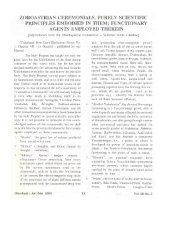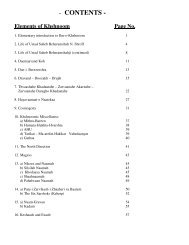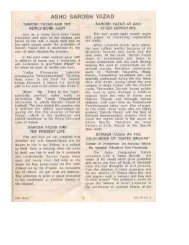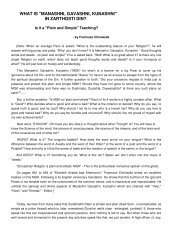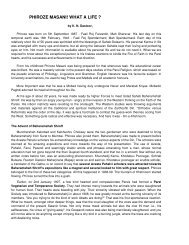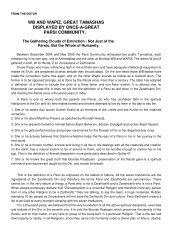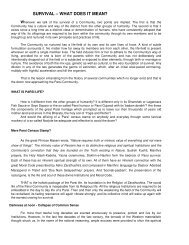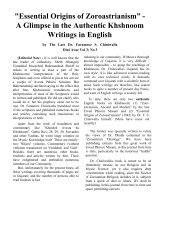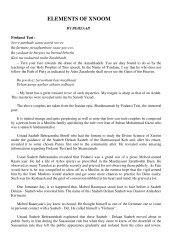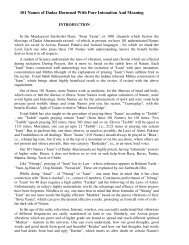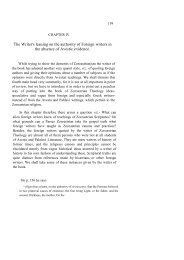Ilm-e-Khshnoom - Traditional Zoroastrianism: Tenets of the Religion
Ilm-e-Khshnoom - Traditional Zoroastrianism: Tenets of the Religion
Ilm-e-Khshnoom - Traditional Zoroastrianism: Tenets of the Religion
Create successful ePaper yourself
Turn your PDF publications into a flip-book with our unique Google optimized e-Paper software.
WHAT IS ILM-E-KHSHNOOM AND WHY?<br />
How <strong>the</strong> Astute Savant Khurshedji Camaji was Formidably<br />
Impressed by Bahermshah Shr<strong>of</strong>f.<br />
The Dawn <strong>of</strong> <strong>Khshnoom</strong> in Bombay - 75 Sittings By <strong>the</strong> Gujerati<br />
IV Standard - "Uneducated" , with B.A.’s M.S.’s and Ph.D's !!<br />
by N. Khurshedji<br />
The arrival <strong>of</strong> Baheramshah Shr<strong>of</strong>f in <strong>the</strong> assembly <strong>of</strong> Manchershah Kekobad was, according to his<br />
inspirational messages, guided by <strong>the</strong> "Gebi Sahebs". So also Baheramshah's agreeing to go to Mumbai,<br />
after tremendous persuasion.<br />
After narrating <strong>the</strong> events upto this point Manchershah proceeds:<br />
"Baheramshah was made to arrive in Mumbai. Initial lectures were delivered. As expected, <strong>the</strong>re was<br />
some opposition from certain direction. However in one <strong>of</strong> his lectures <strong>the</strong> late (K.R.) Camaji was <strong>the</strong><br />
President. He admitted that this was surely Zoroastrian Philosophy, but <strong>the</strong> technical terms are quite<br />
new, <strong>the</strong>refore more we will hear him, more, will we be able to understand. In <strong>the</strong> same assembly an<br />
Avesta scholar asked, "Where has he <strong>the</strong> knowledge <strong>of</strong> Avesta Pahalvi ?" Many remember till now<br />
Camaji's reply: "Bro<strong>the</strong>rs ! What more have you done except just translating <strong>the</strong> words? Where<br />
have we been able to <strong>of</strong>fer any explanations <strong>of</strong> <strong>the</strong> Mysterious Writings. I feel that this man has<br />
got something, we do not have. Let us wait and see."<br />
Who was this K.R. Cama who implied in <strong>the</strong> above words that mere philological and etymological<br />
translations done in <strong>the</strong> West oriented studies, were not adequate; that Religious writings were mysterious<br />
and required deeper explanations than <strong>the</strong> dry grammatical exertions; and that this man Baheramshah Shr<strong>of</strong>f<br />
had such explanations as <strong>the</strong> scholars <strong>of</strong> Avesta Pahalvi did not have? K. R. Cama was himself <strong>the</strong> pioneer <strong>of</strong><br />
<strong>the</strong> Western Studies. It was he, who was mainly responsible for bringing those studies to India. After a long<br />
journey in <strong>the</strong> line <strong>of</strong> <strong>the</strong>se studies, he was not satisfied. There was something seriously missing and that was<br />
<strong>the</strong> mystical side <strong>of</strong> Din-e-Zarathushtra. As we will see later in <strong>the</strong> words <strong>of</strong> o<strong>the</strong>r weighty witnesses, Camaji<br />
was greatly attracted towards <strong>the</strong> mystical truths revealed to him by Baheramshah, and had adopted as<br />
correct <strong>the</strong> meanings <strong>of</strong> several words from Avesta Scriptures as explained to him by Baheramshah.<br />
Let us now continue our story from <strong>the</strong> point where Manchershah left it.<br />
Baheramshah came to Bombay in 1908. How <strong>the</strong> presentation <strong>of</strong> IIm-e-<strong>Khshnoom</strong> started <strong>the</strong>re, has<br />
been very interestingly described by Sohrabji Nanabhai Banaji in his Gujerati Article in <strong>the</strong> Baheramshah<br />
Shr<strong>of</strong>f Memorial Volume (1930), page 331 onwards. Sohrabji belonged to <strong>the</strong> Banaji family, which was well<br />
known for its public charitable and religious activities. Banajis had a major hand in establishing <strong>the</strong> 289 years<br />
old Banaji-Limjee Agiary at Fort and <strong>the</strong> Banaji Atash-Baheram at Charni Road, Mumbai. The family was<br />
nurtured in intense faith for <strong>the</strong> Daena and its spiritual Institutions.<br />
Sohrabji Banaji’s historical article, titled "How Did Sheth Baheramshah Navroji Shr<strong>of</strong>f start IIm-e-<br />
<strong>Khshnoom</strong> in Mumbai?" begins with <strong>the</strong> following passage:<br />
"In 1908 A.D. I received a printed, postcard bearing <strong>the</strong> signature <strong>of</strong> Mr. Khodabux Edaliji Poonegar,<br />
wherein an amazing matter was stated to <strong>the</strong> effect that one gentleman from Surat by name Mr.<br />
Baheramshah Navroji Shr<strong>of</strong>f had a sudden contact with a Zarathoshti clan staying in a secret cave at <strong>the</strong><br />
North <strong>of</strong> Iran, who is preserving our <strong>Religion</strong> and 'Tarikat's since a long time; that Mr. Shr<strong>of</strong>f had been to<br />
Iran (with that clan) and brought some knowledge <strong>of</strong> <strong>Religion</strong>; and that I may remain present at <strong>the</strong> hall <strong>of</strong><br />
<strong>the</strong> Bengali School at Fort, to visit him.<br />
"Those few lines were enough to invoke my curiosity and so I set aside all my o<strong>the</strong>r work and remained<br />
present.<br />
"In presence <strong>of</strong> <strong>the</strong> late Sheth Khurshedji Rustomji Camaji and 30 o<strong>the</strong>r students <strong>of</strong> Avesta<br />
Pahalvi, a simple elderly gentleman <strong>of</strong> old traditional appearance described his aforesaid journey<br />
18



